Pop Quiz: Anastasia Limestone is (a) the main character in Agatha Christie’s last novel, (b) the band that headlined the second day at Lollapalooza last year, (c) the name of the rock formation that gives the Conservancy’s Blowing Rocks Preserve in Florida its name, or (d) all of the above.
The answer is (of course) “c;” Anastasia limestone is a type of sedimentary rock that most scientists agree was laid down during the last half of the Pleistocene about 120,000 or so years ago. That said, you’re in good company if, even for a second, you wondered if the answer could be “d” because, really, all three choices are perfectly plausible for a name like Anastasia limestone.
In fact, the name isn’t even the most interesting thing about this rock that puts the, well, blow in the rocks of Blowing Rocks Preserve.
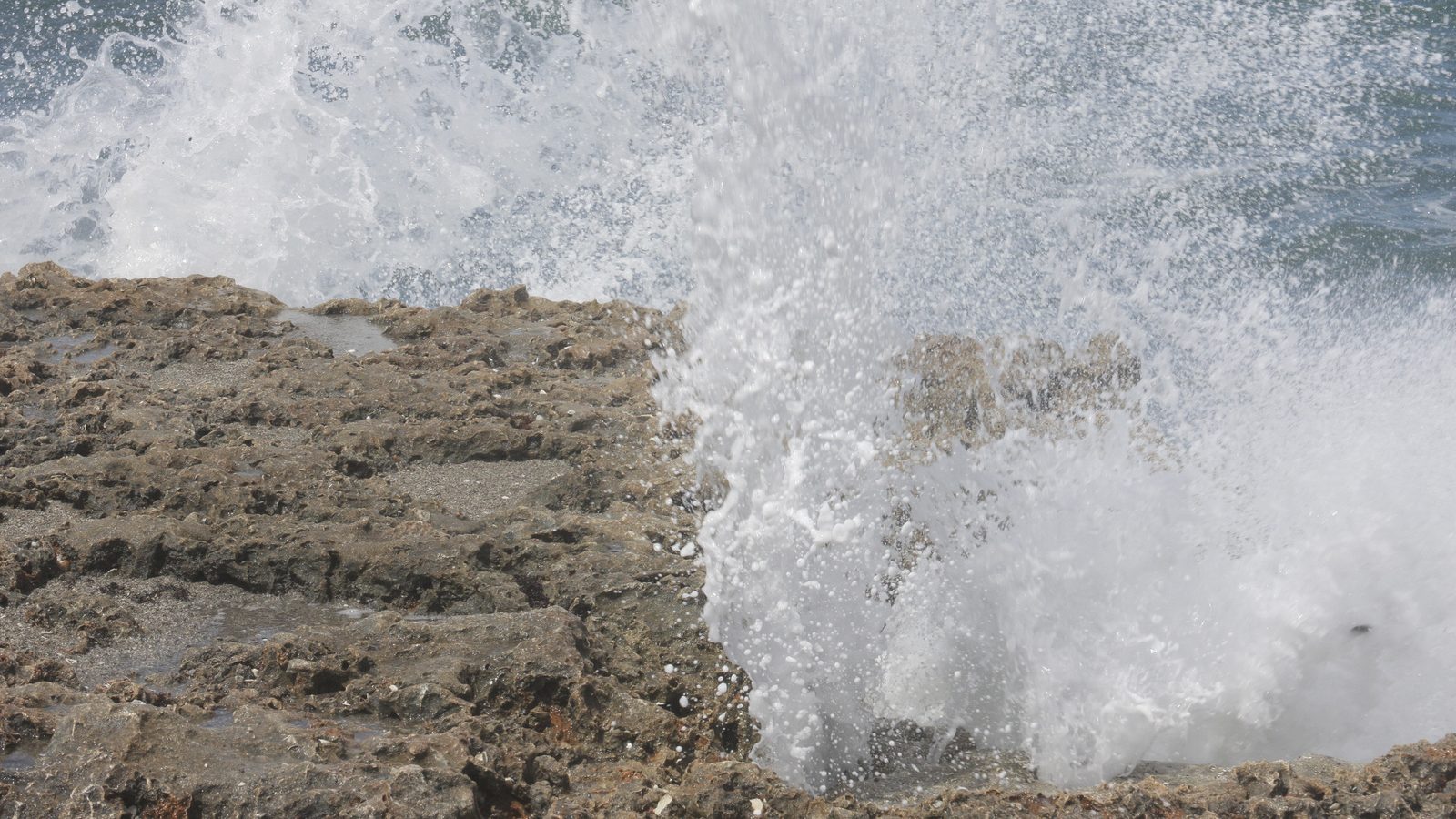
© JMC Photography
A Story of Shells, Corals, Sands and Time
To me, the most interesting thing about Anastasia limestone is its contrasts—it is both dramatic and modest, grand and intimate. You don’t have to look closely to appreciate the awesome beauty of the rocks erupting like geysers during winter storms and high tides. When Atlantic waves shoot through the blow holes, they throw white ribbons of foaming sea water as high as 50 feet into the open Florida sky.
But the rocks also reward closer, more careful inspection. When you look carefully at Anastasia limestone, with its eons-old fossils peppering the surface, you know you’re looking at the visible remnants of an ancient natural history written in sandstone, a story of warm shallow waters, shells, corals, sands and time. The rocks here offer a glimpse of the past when this part of what is now Jupiter Island was a sand bar or the top of a reef that somehow held above the ocean when much of the rest of what is now Florida was repeatedly inundated and drained as the seas rose and fell, and rose and fell.
The blowing rocks at Blowing Rocks Preserve are largely the result of that happy accident and because Anastasia limestone is, as one Florida state geologist described it, a kind of “fossiliferous sandstone,” it is primarily composed of calcium carbonate from the remains of animals that lived and died here at the end of the Pleistocene.
Why do the Blowing Rocks Blow?
Calcium carbonate in the limestone is why the Blowing Rocks blow. Well, calcium carbonate and its tendency to erode in interesting and mysterious forms when exposed to acids in rain and sea water. At Blowing Rocks, the rocks blow because they have been eroded over time into wind-, wave- and rain-carved chimneys, ledges and shelves, sea stacks, caves, arches, blow holes and rocky pools.
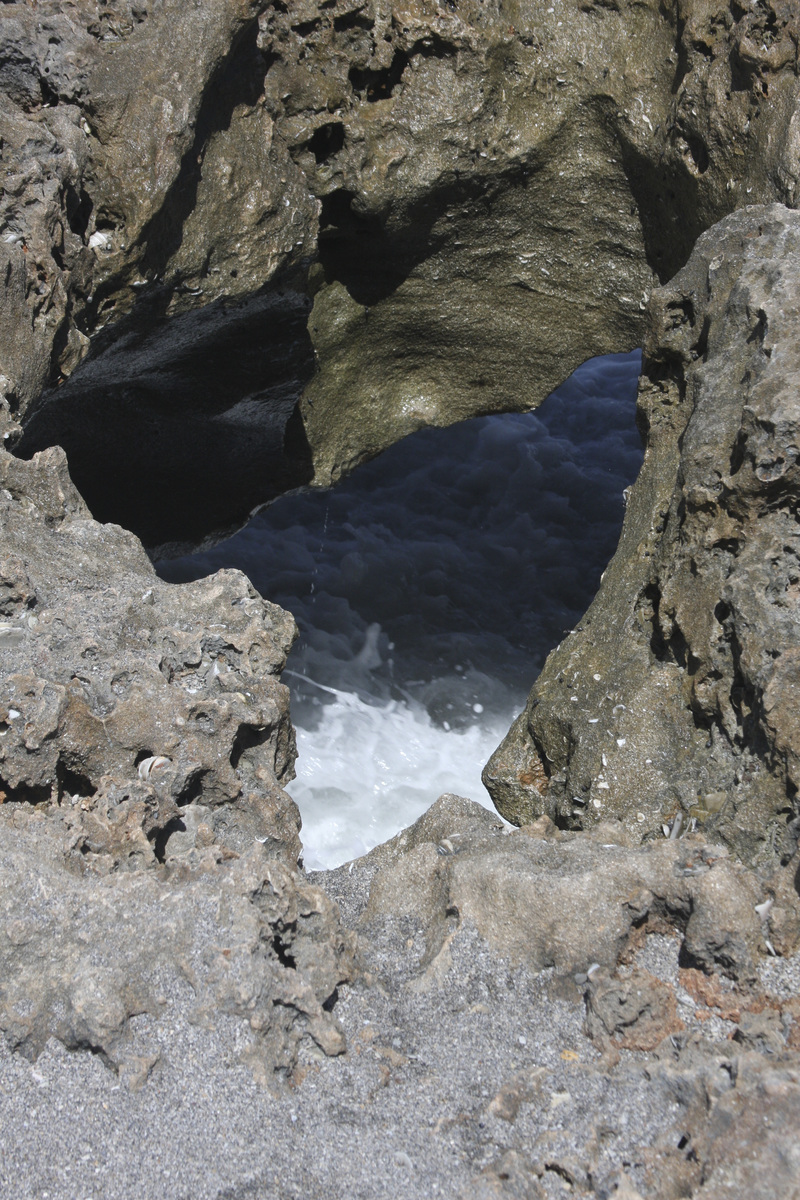
It’s the blow holes (the holes deeper than 1 meter are also known as “solution pipes”) that are the namesake of Blowing Rocks Preserve. These holes in the rock, open on both ends, are where the irresistible force of the ocean meeting the immovable object of the Anastasia limestone plays out most spectacularly as water blows from the rocks in flumes and fountains.
About that Fossiliferous Sandstone
And while the big drama of the blow holes gets most of the attention, don’t overlook the small dramas recorded in the limestone. Even a cursory glance at the shoreline rocks reveals fossil impressions crisp and clear enough for scientists (and curious amateurs) to identify the individual species that left them.
Most of the fossils found in the limestone of Blowing Rocks are different types of mollusks, with a species known as “busycon” —a kind of whelk—believed to be among the most common. I’ve spent many happy hours at the preserve clambering over the rocks with my kids and a well-worn fossil guide to Florida, and highly recommend it.
If storms and high tides are the best times to see the rocks really blow, low tides are the best times to hunt for fossils because you get to the explore the rocky ledge and poke around in the blow holes without getting a face full of sea water. (A lesson my older son only had to learn only once. It took me a little longer.)
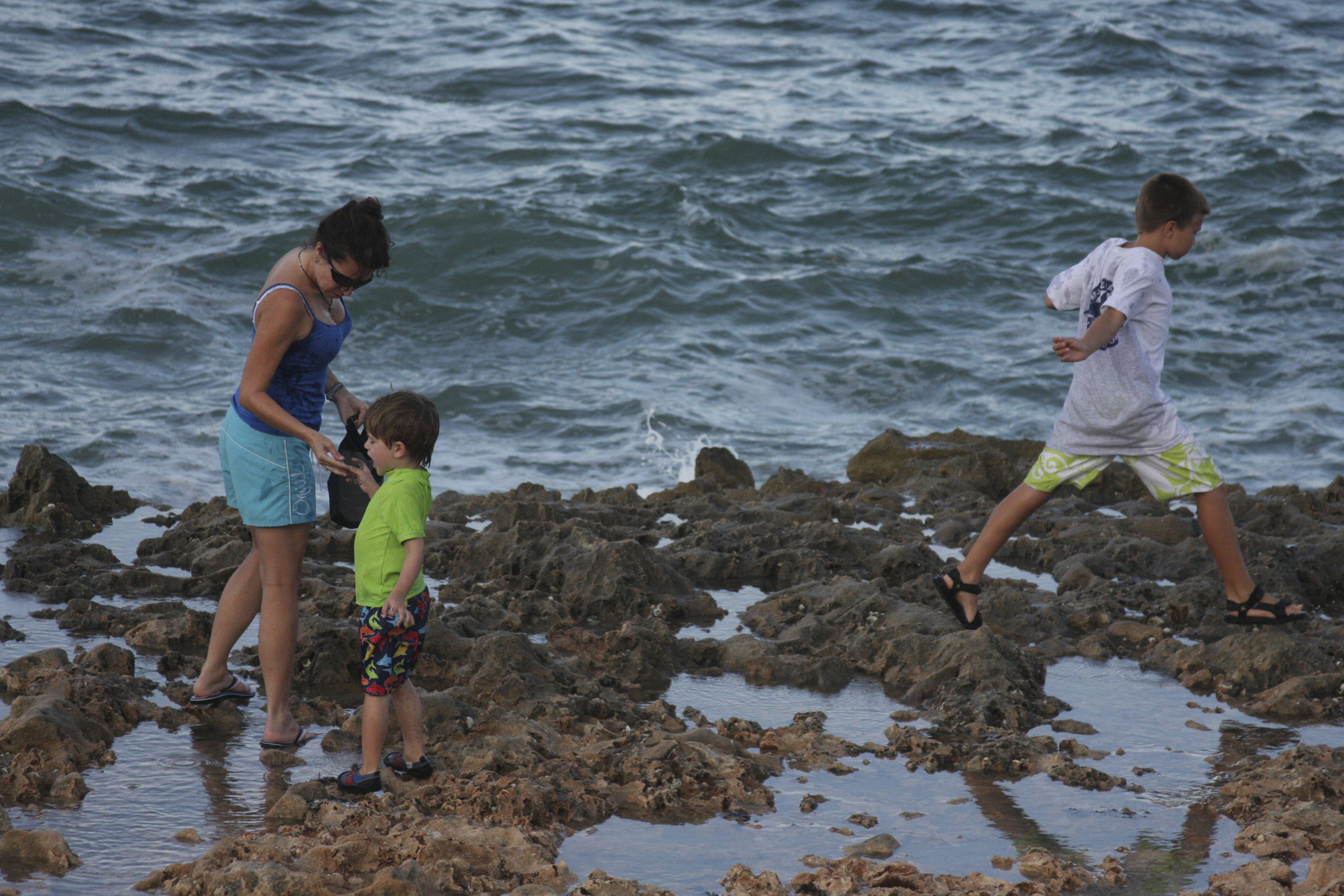
What’s in a Name?
This part of Anastasia limestone’s history is a little convoluted and involves, well, Spanish conquistadors, so bear with me here.
First, Anastasia limestone itself is not particularly rare. It is the rock formation that underlies much of the the East Coast of Florida. It runs along the coastal ridge, from Anastasia Island (its namesake island) in the north near St. Augustine, then down the coast for about 300 miles to Jupiter Island and West Palm Beach, until it shades into another kind of limestone called Miami oolite a little south of Boca Raton. Scientists disagree about how far inland Anastasia limestone extends.
And though it’s true that Anastasia limestone itself is not unusual, most of it is found either underwater or underground. Exposed formations—like the one at Blowing Rocks—are very rare. There are a few other places besides the Conservancy’s preserve that boast outcroppings of Anastasia limestone, but with nearly a mile of exposed rock on the shoreline, Blowing Rocks harbors the largest known outcropping of Anastasia on the U.S.’s East Coast.
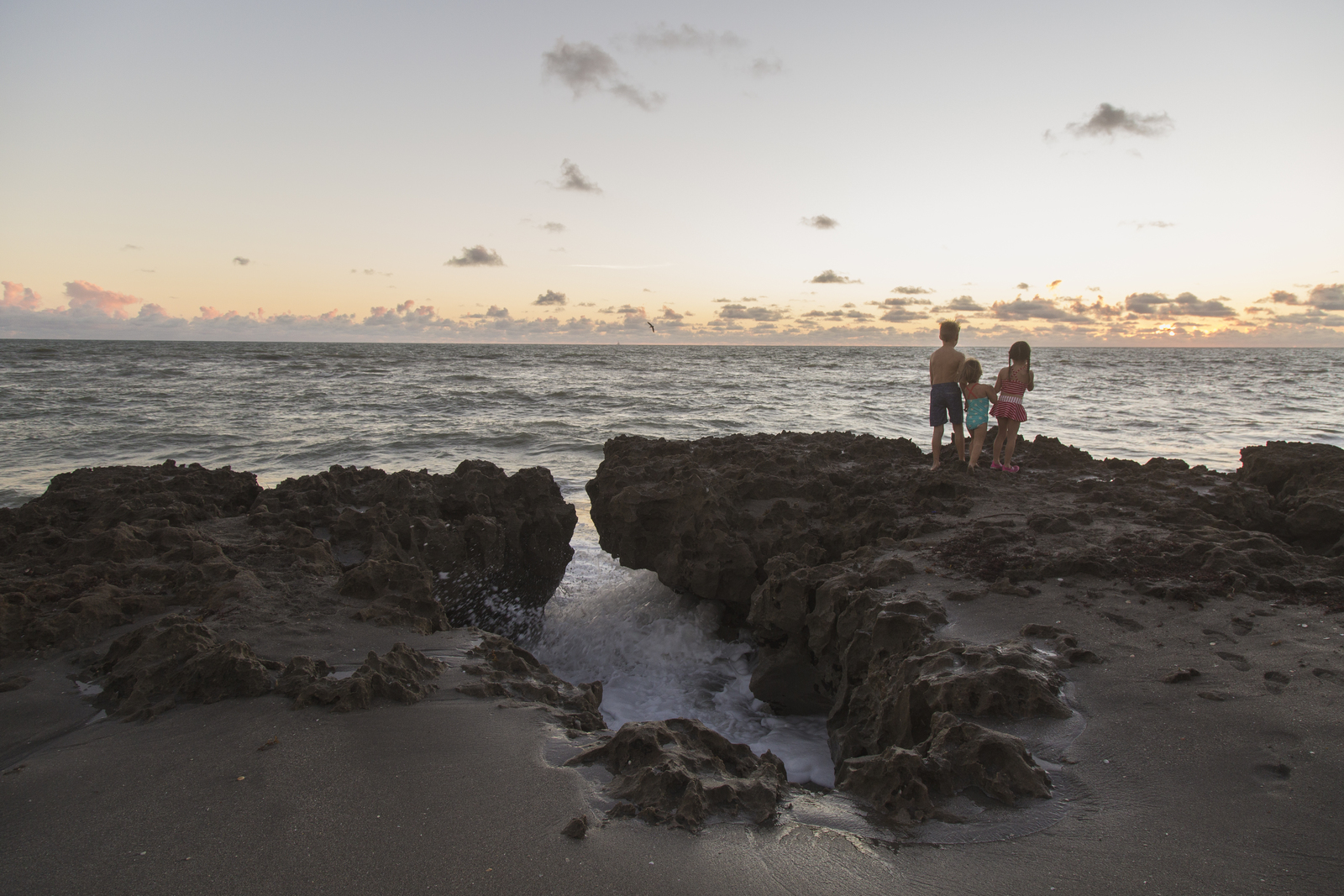
Which takes us back to St. Augustine, Anastasia Island, the conquistadors and the fort they built out of a local limestone they called “coquina.” It’s the Spanish word for cockleshell, after the fossil shells they could see in the rock. It’s apparently not the easiest material to work with for construction and work on the fort began in 1670 and continued for more than 20 years. (Today, coquina is pretty much synonymous with Anastasia limestone, except possibly to geologists, who occasionally refer to Anastasia limestone as “coquinoid limestone.”)
Back to the Spanish. To build their fort—Castillo de San Marcos—they mined coquina from a nearby island where there was a small chapel dedicated to St. Anastasia. It’s not clear when the island was officially named for Anastasia, but the a usage of the name Isla de Santa Anastasia is found on a Spanish chart dating to the 1730s.
St. Anastasia herself was apparently the Catholic patron saint of martyrs, weavers and those suffering from poison. What that has to do with limestone, islands, or quarries, I’m not really sure, but Anastasia Island eventually got its name from that chapel and its saint. And by extension, Anastasia limestone did, too.
You can still visit the pit quarries on the island where the limestone was mined. They’re part of Florida’s Anastasia Island State Park, a short walk down a sandy trail just off the the main park road that will take you to the beach. You can also tour the 300-year-old fort built of coquina—Castillo de San Marcos—within sight of the Bridge of Lions in St. Augustine.
For more information on visiting the Conservancy’s Blowing Rocks Preserve in Jupiter, you can find hours, details and a virtual tour here. As fascinating as the blowing rocks are, they are only one part of this remarkable place with its restored native intact Florida dune habitat with beach sunflower, bay cedar, sea grapes and sea oats.
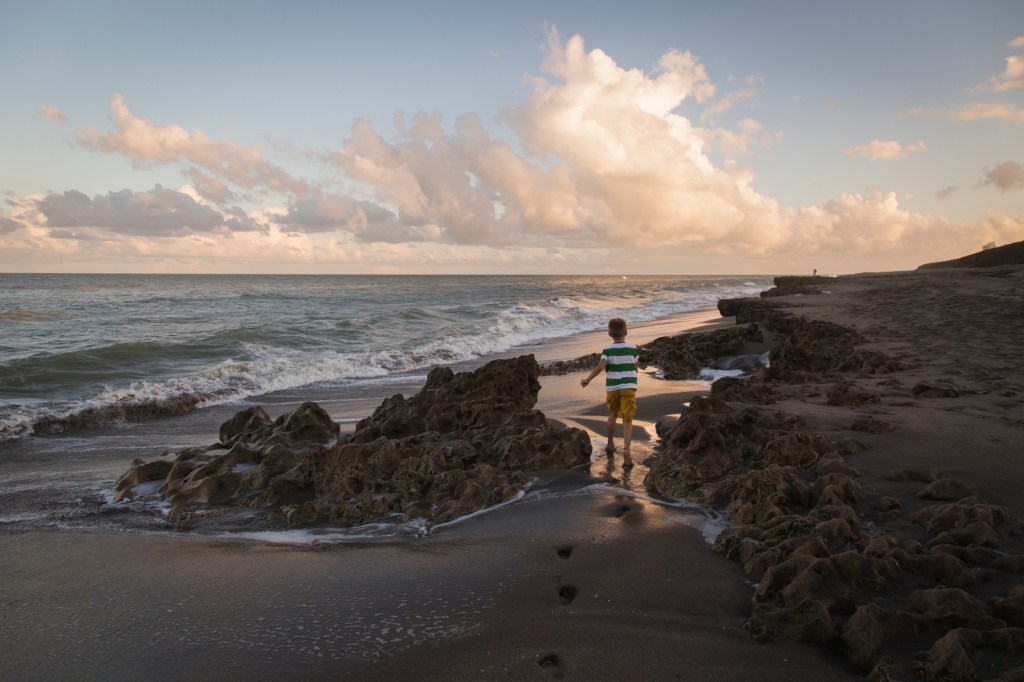



Join the Discussion
1 comment